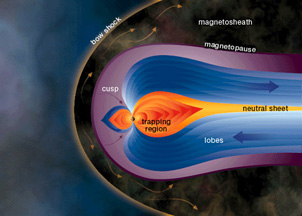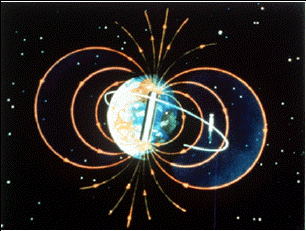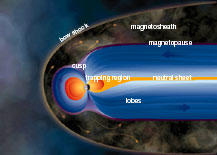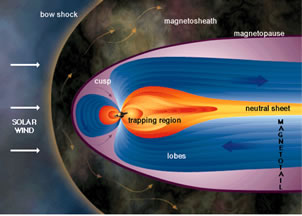Click on image for full size
Windows to the Universe original artwork
Detecting Planetary Magnetism
A magnetometer is an instrument for measuring magnetic fields. Many spacecraft carry magnetometers to measure the magnetic fields around planets. When a spacecraft makes those measurements, what do the measurements tell us?
The planet might have a global magnetic field surrounding it. Earth does, which is why compasses work. So do Mercury, Jupiter, Saturn, Uranus, and Neptune. Electrical currents in Earth's core generate its magnetic field. The core consists of iron and nickel, which are good conductors of electricity. Similarly, Mercury has an iron core which produces its field. Areas surrounding the cores of Jupiter and Saturn are filled with liquid metal hydrogen. This strange substance exists only at the high pressures and temperatures found deep inside massive gas giant planets. Flow of electricity in the liquid metal hydrogen produces the strong magnetic fields Jupiter and Saturn. The magnetic fields of Uranus and Neptune are generated by current flow in slushy, salty water inside those frozen gas giants.
The planet might have smaller magnetic fields that surround just part of the planet. The planet might have had a global magnetic field when it was younger. Whatever is left of that field can stay "locked into" rocks formed during earlier times. Mars and Earth's Moon seem to have local magnetic fields like that. A magnetometer might also show the location of large deposits of ores such as iron. Ore deposits could even be the remains of an asteroid that struck the planet!
The spacecraft also might detect magnetism caused by the solar wind or the Sun's magnetic field. The solar wind is the flow of electrically charged particles emitted by the Sun. The solar wind carries the Sun's magnetic field outward through the Solar System. Since the Sun's magnetic field is so strong, the spacecraft's magnetometer might detect the Sun's field even when the spacecraft is near a planet. Charged particles from the solar wind can also become trapped within a planet's magnetosphere, if the planet has one. The movement of particles within the magnetosphere can also produce magnetic fields.
Finally, the magnetic field detected by a spacecraft might be a combination of several of these effects. For example, the magnetic field near Earth is a result of the combination of Earth's global field, charged particles racing around Earth's magnetosphere, and other factors.














